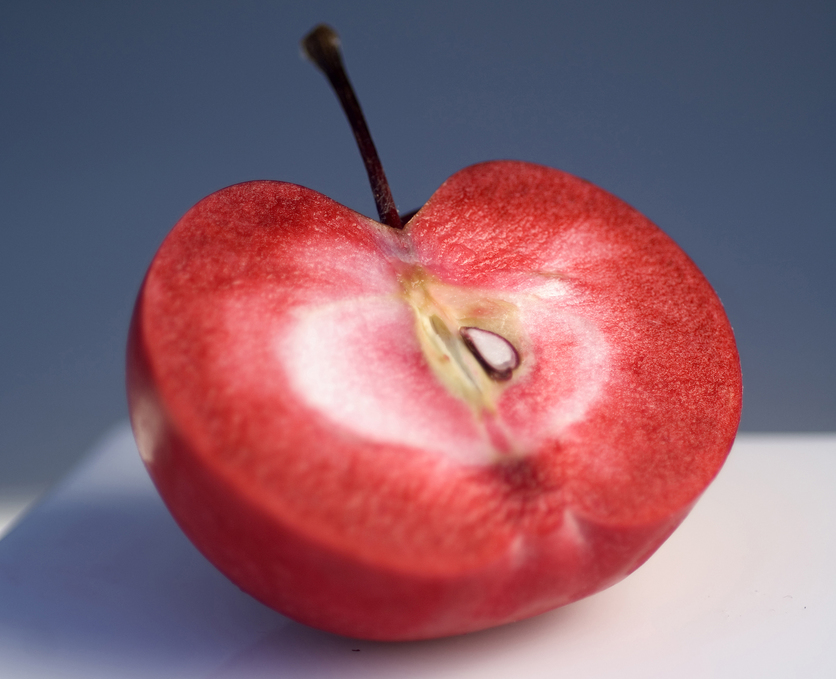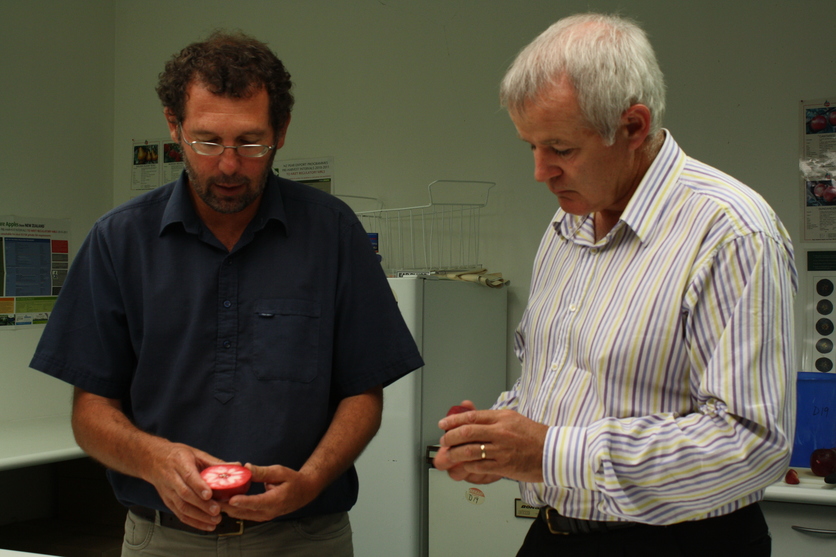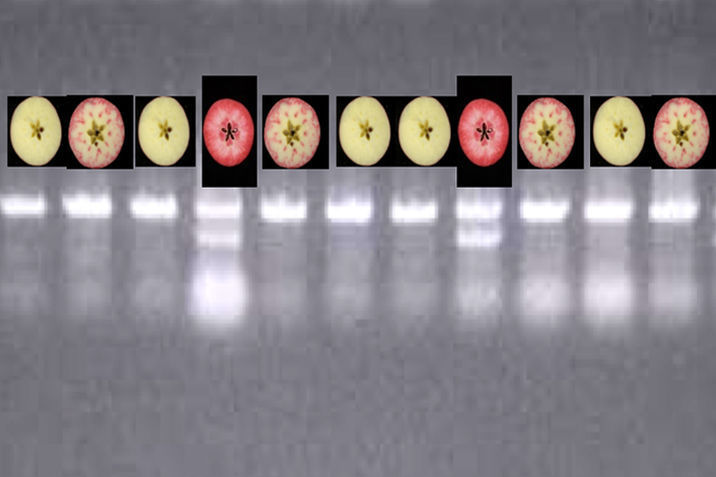Find out how and why a red-fleshed apple variety is being bred in New Zealand, and discover how genetic information, consumer research and sensory science are all involved.
Red-fleshed apples – unique and healthy
Most apple varieties have white flesh, but scientists at Plant & Food Research (PFR) are developing a new apple with red skin and red flesh. Apart from novelty value, these apples may also have health benefits – the red colour is caused by anthocyanins, which are antioxidants and can help protect against disease.
Discover how the idea came about and why it may appeal to consumers in this article, Why breed a red-fleshed apple?
Breeding red-fleshed apples
The idea of breeding a red-fleshed apple came from the wild apple forests of Kazakhstan, where the apple originated. PFR scientists collected seed from these apples and grew trees back in New Zealand, in their germplasm collection. The wild apples had striking red flesh, but the fruit was small, tasted bitter and lacked the quality attributes that today’s consumers expect.
To improve the apples’ taste, scientists at PFR crossed the original red-fleshed apple with commercial white-fleshed varieties. Now they’re improving other characteristics important for consumer acceptability and commercial success, such as long storage life.
Meet the scientists Dr Brent Ennis and Dr Richard Espley.
A new apple cultivar must meet quality criteria for approximately 45 different traits before it’s considered for possible commercialisation by PFR. This takes several rounds of breeding and is a decades-long process. Breeding a new apple cultivar explains this lengthy process.
Genetic information streamlines breeding
New apple varieties in New Zealand are developed through selective breeding – the same technique used by humans for thousands of years. However, breeders can now use genetic information to make the breeding process faster and more efficient. By analysing DNA from apple seedlings, they can predict many apple characteristics (including red flesh) long before the seedlings produce fruit, so they can decide which seedlings are worth growing and which can be discarded.
In 2010, the sequence of the apple genome was published by an international team that included PFR scientists. The genome sequence is helping breeders to streamline the breeding process even further. Find out how information about apple genetics is helping breeders at Plant & Food Research.
Discovering the genes that control apple colour
Geneticists at PFR have discovered why some apples have red flesh. They found that flesh colour is controlled by a gene called MYB10, which is expressed in higher amounts in red-fleshed apples than in white-fleshed apples.
Understanding this type of genetic information often helps to improve breeding. In this interactive Dr Richard Espley explains how transgenic plants are created in a laboratory. This process enables scientists to discover more about individual plant traits. However, it is confined to the lab – apple breeding in New Zealand does not use transgenic techniques.
The role of sensory and consumer science
Consumer scientists play a key role in plant breeding. In the early stages of developing a new fruit, their research can give breeders an insight into the type of consumer who will buy the fruit and the attributes they value.
Once there’s fruit available, consumer scientists run sensory trials to test the taste and texture attributes of the fruit with consumers. This can help breeders to target consumer groups and develop an appropriate trademark and marketing campaign.
Taking the new apple to market
Commercialising a new apple variety in the market is the end point of a very long process – approximately 25–30 years from the first breeding step. For a new variety to be successful, the entire process needs to be carefully managed. Protecting intellectual property is a crucial part of the process.
As of 2023, the red-fleshed apple is yet to be commercialised. In 2019 the science team were able to conduct trials to taste test some of the apples they’d bred from combining two different species of apples. Due to regulations around genetically modified fruit the team had to travel to America to run the taste tests. And the result? The taste testing panel in America liked the taste of the apples and were surprised to see the colour when they removed their blindfolds. However, the ‘crispness’ ratings were not up to the standard apple consumers prefer – so it’s back to the glasshouse containment facility for the team!
Take up the challenge
Students can have first hand experience with fruit research and consumer preferences. The activities Investigating apple attributes, Instrumental firmness test and Consumer research on future apples encourage students to explore apple varieties and consumer preferences.
The unit plan, Developing future apple varieties, helps students understand the influences driving the development of new apple varieties and encourages critical thinking and informed predictions regarding future cultivars.
Pollination teaching ideas
To help students develop their understanding of pollination, you could try these activities:
Useful link
Read more about the work and taste testing of the red flesh apples in this 2019 news article Genetic modification and Auckland’s forbidden fruit.



